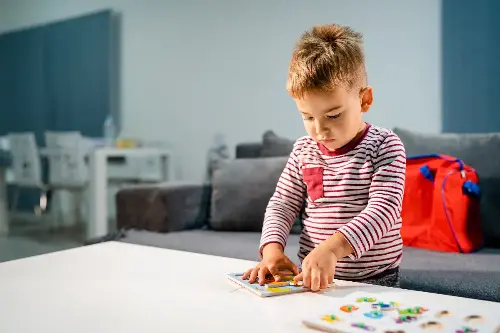In the bustling orbit of childhood, where playmates and siblings often become integral to day-to-day play, it's important to remember the significant role that solo games play in a child's development. These self-dependent activities are more than just pastimes; they are tools that enhance creativity, bolster problem-solving skills, and encourage self-sufficiency. Here we highlight six enchanting solo games that not only keep the little ones engrossed but also allow their imaginations to soar, all while fostering an environment conducive to independent play.

The Timeless Puzzle
One beloved classic is the puzzle. Whether it's a simple wooden block puzzle for toddlers or a complex jigsaw for older children, the act of piecing together a puzzle encourages patience and critical thinking. The child learns to identify shapes, colours, and patterns, creating a sense of achievement upon completion. What's more, puzzles come in a variety of themes and difficulties, providing a challenge that can grow with the child.
Innovative Construction Toys
Secondly, we have construction toys such as Lego or magnetic tiles. These offer an open-ended canvas for children to construct anything from fantastical castles to intricate vehicles. As they manipulate these small pieces into grand designs, children are exploring the fundamentals of engineering and spatial awareness. Moreover, such play can be a peaceful retreat where young minds lose themselves in the realm of creation.
Educational Apps and Games
A more modern addition to solo play is the educational app or computer game. While screen time should be monitored, there's a treasure trove of software specifically designed to be intellectually stimulating and fun. These interactive games can help children learn everything from math to languages, all in an engaging format that feels more like play than work.
Art Supplies for Creative Expression
Moving on to the tangible again, art supplies such as crayons, paint, and clay offer an opportunity for self-expression without words. A child with a set of watercolours and paper has the freedom to paint their emotions, thoughts, and dreams. Artistic play is critical; it allows children to experiment with textures and colours, and the act of creating something from nothing is inherently rewarding.
Pretend Play and Role-Playing
Pretend play is another sphere where children often thrive alone. Dolls, action figures, and even stuffed animals can take on roles and personalities in a child's solo drama. Here, through role-play, children explore social situations, learning empathy and communication. This type of play can be particularly reassuring, as kids rehearse real-life scenarios in a safe, controlled environment.
Outdoor Adventures for Independence
Last but not least, we have the great outdoors as a haven for solo play. Activities like skipping rope, riding a bicycle, or simply engaging in a nature scavenger hunt allow children to enjoy the fresh air and physical activity, all while developing their independence. These activities not only provide an entertaining challenge but also imbue children with a sense of freedom and adventure.
Each of these games shares a common thread—they can be initiated, sustained, and concluded by the child themselves. In doing so, they build a foundation of self-reliance. As children play alone, they learn to make decisions, solve problems independently, and manage their emotions—all skills that will serve them well throughout life.
However, it's worth remembering that solo play is not about isolating children but giving them the skills and confidence to be by themselves comfortably. It complements social play, rounds out a child’s experiences, and reinforces the notion that they are their own best company. As kids grow and become more self-sufficient, these solo games can remain a favourite pastime and a refuge of comfort and creativity.
While the trend may lean towards ever-more interconnected play options, these six types of solo games are testament to the undying value of independent playtime. They prove that the most memorable and developmental moments can indeed come through the simple acts of assembling, imagining, creating, and exploring alone. In nurturing these habits, we are not just keeping our children occupied; we are aiding them in their journey to becoming resourceful, imaginative, and resilient adults.
